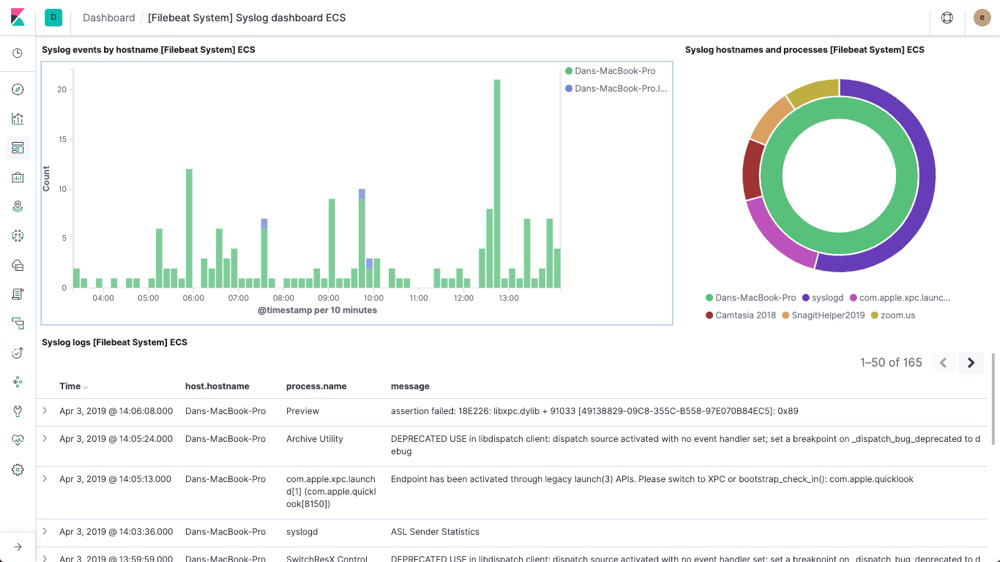Dec 07, 2018 Filebeats is light weight application where as Logstash is a big heavy application with correspondingly richer feature set. HOW Filebeat has been made highly configurable to enable it to handle a large variety of log formats. Filebeat is a log shipper belonging to the Beats family: a group of lightweight shippers installed on hosts for shipping different kinds of data into the ELK Stack for analysis. Jan 07, 2021 Ingesting logs. Kibana, the visualization and administrative interface for the Elastic Stack, you’ll find instructions for the installation of Filebeat, which we’ll use to ingest the Azure activity, sign-in, and/or audit logs mentioned earlier. Jun 13, 2018 Nowadays, Logstash is often replaced by Filebeat, a completely redesigned data collector which collects and forwards data (and do simple transforms). Here we’ll see how to use an unique Filebeat.
Filebeat is well known for being the most popular lightweight log shipper for sending logs to the Elastic Stack due to its reliability & minimal memory footprint. It is the leading Beat out of the entire collection of open-source shipping tools, including Auditbeat, Metricbeat & Heartbeat.
Filebeat forms the basis of the majority of ELK Stack based infrastructure. It’s origins begin from combining key features from Logstash-Forwarder & Lumberjack & is written in Go. Within the logging pipeline, Filebeat can generate, parse, tail & forward common logs to be indexed within Elasticsearch. The harvester is often compared to Logstash but it is not a suitable replacement & instead should be used in tandem for most use cases.
Earlier versions of Filebeat suffered from a very limited scope & only allowed the user to send events to Logstash & Elasticsearch. More recent versions of the shipper have been updated to be compatible with Redis & Kafka.
A misconfigured Filebeat setup can lead to many complex logging concerns that this filebeat.yml wizard aims to solve. Just a couple of examples of these include excessively large registry files & file handlers that error frequently when encountering deleted or renamed log files. Tracking numerous pipelines using this shipper can become tedious for self hosted Elastic Stacks so you may wish to consider our Hosted ELK service as a solution to this.
If you need any further assistance with migrating your Filebeat log data to the Elastic Stack we're here to help you get started. Feel free to get in contact with our support team by sending us a message via live chat & we'll be happy to assist.
This tutorial on using Filebeat to ingest apache logs will show you how to create a working system in a jiffy. I will not go into minute details since I want to keep this post simple and sweet. I will just show the bare minimum which needs to be done to make the system work.
WHY
Apache logs are everywhere. Even Buzz LightYear knew that.
And then there is a growing user base of people who are increasingly using ELK stack to handle the logs. Sooner or later you will end up with Apache logs which you will want to push into the Elasticsearch cluster.
There are two popular ways of getting the logs in Elasticsearch cluster. Filebeats and Logstash. Filebeats is light weight application where as Logstash is a big heavy application with correspondingly richer feature set.
HOW
Filebeat has been made highly configurable to enable it to handle a large variety of log formats. In real world however there are a few industry standard log formats which are very common. So to make life easier filebeat comes with modules. Each standard logging format has its own module. All you have to do is to enable it. No messing around in the config files, no need to handle edge cases. Everything has been handled. Since I am using filebeat to ingest apache logs I will enable the apache2 module.
First install and start Elasticsearch and Kibana. Then you have to install some plugins.
2 | curl-L-Ohttps://artifacts.elastic.co/downloads/beats/filebeat/filebeat-6.5.2-x86_64.rpm |
Then you make changes to the /etc/filebeat/filebeat.yml file to specify the connections. Since I am not using security this section will be easy.
Filebeats Module
2 4 6 8 10 12 14 16 | # Access logs enabled:true # Set custom paths for the log files. If left empty, # Filebeat will choose the paths depending on your OS. error: # Set custom paths for the log files. If left empty, # Filebeat will choose the paths depending on your OS. |
Best practice is to leave it as it is and let filebeat figure out the location based on OS you are using. And I will do the same.
With that done the next command to run is
Setup makes sure that the mapping of the fields in Elasticsearch is right for the fields which are present in the given log.
Before we start using filebeat to ingest apache logs we should check if things are ok. Use this command:
You want to see all OK there.
Once that is done then run the filebeat.

To stop it

However since I do not have apache server running I downloaded some logs for demo purpose. And I will pass them at command line. Hence I need to run the filebeat in foreground.

